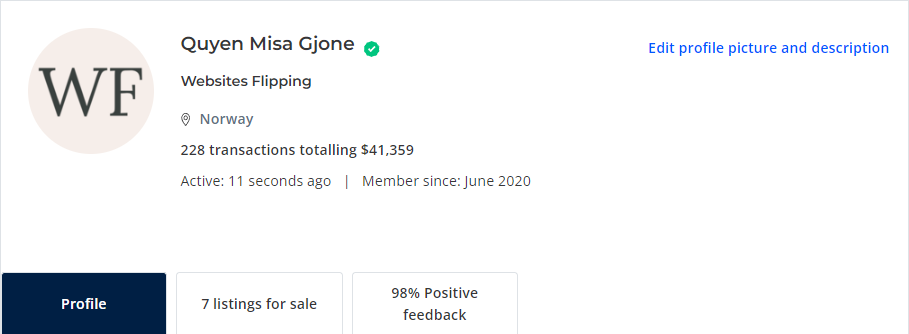Blog Flipping Blueprint: How I Made $41K Selling Starter Sites
I’ll be honest here: 2023 was NOT a good year for me with my blog flipping business. In fact, that year ended up in negative profit and I almost gave up. Reasons? I have two in my head:
- The personal reason is because I poured my heart into my corporate job. Although I have my VA to help with a lot of things, still, for a business to thrive, you need a leader who’s fully present for the business.
- The other reason is, after my own observation, mainly because of the world’s economy, like, the aftermath of the pandemic. People didn’t know if they should invest in a website or not, hence slowing down the sales.
But despite the challenges, I still managed to make a full-time salary selling niche sites (well, not last year, of course). On Flippa alone, I’ve made so far over $41,000, and I do sell from outside the platform, in private Facebook groups, and from my own network.

And then, I’ve been approached by aspiring blog flippers to teach them my ways – how I started, which courses did I take, how to get clients, how to negotiate, and so on.
Although I did have a plan to have a blog flipping course in English (I have one in Vietnamese, by the way), life happened and I got distracted by so many things around. Plus, I simply don’t have time to put up a course.
But, as they say, when you write it down, you have a higher chance of making it happen. So here I am, writing this blog flipping blueprint for you – the aspiring blog flipper who wants to make a full-time income from buying and selling websites.

What Is Blog Flipping?
If this is your first time reading my blog, here are some articles you can read for a deeper understanding of blog flipping before we go into the details of this blueprint.
- What Is Blog Flipping?
- The Ultimate Guide to Blog Flipping
- 20 Things I’ve Learned After Flipping Over 200 Blogs
In short, blog flipping or site flipping is the process of buying, improving, and selling websites for a profit. This can include creating websites from scratch, purchasing existing websites and making improvements, or simply buying low and selling high.
Why Blog Flipping
Before jumping on this wagon, I tried several ways of making money online, including freelancing, affiliate marketing, and blogging. All of them required a significant amount of time and effort with no guaranteed results.
Also, for the things I didn’t try like dropshipping, investing or e-commerce, the idea of dealing with inventory, customer service, and shipping logistics was a turn-off for me. I just want to make money from my laptop without all that hassle.
Now, take the brick and mortar business, for example, buying a shop and selling it in 6 months for double the price is unlikely to happen. At least not for me.
And the last things I could have thought about was house flipping and furniture (or any physical things) flipping. Some people might be good at it, but again, that person is definitely not me. Plus, I simply don’t have that much money for real estate investment!
Blog flipping, on the other hand, has low barriers to entry and can generate high returns in a relatively short amount of time. It perfectly fits my criteria for a lucrative online business without a huge initial investment, worrying about inventory, or dealing with physical products.
When I finally decided to give it a tried back in 2020, I already had a hosting for my travel sites, so all the money I invested was $20 for two domain names.
Three and a half years later, I am writing this article as a full-time blog flipper besides my 9-to-5 jobs. So yeah, like basically I’m working two jobs, but’s it’s so much fun I even don’t think about it that way.
What You Can Expect
For one million and one time, the only thing you can NOT expect is to get rich quick. In fact, there’s nothing such a get-rich-quick business model unless you’re into very shady things.
However, with blog flipping, you can expect a solid return on investment if you put in the effort and follow the right strategies. It’s not an overnight success, but it’s also not a slow burn like many other online business models.
Another thing you can expect is to constantly learn and improve your skills as a blogger and marketer.
Blog flipping requires constant research, analysis, and adaptability to succeed in a competitive market. It’s an ever-evolving industry, so you must stay updated with the latest trends and techniques to stay ahead of the game.
For the last six months, I have changed my business plan for no less than three times. The raise of AI, new tools to the market literally every single day, new demands and trends from the market, etc. all these will add up to the excitement of being a blog flipper.

Getting Started with Flipping Starter Sites
So, if you’re ready for the heat, let me tell you something: There are many blogging bloggers out there writing about blog flipping. And you know what bugs me most? Well, there are actually a few:
- For one reason, a lot of them just wrote about blog flipping since it’s a new keyword. They did some keyword research, found this low-hanging fruit, and then wrote something generic. I’ve been in this business for four solid years, and trust me, I can tell all the differences!
- Also, many of them haven’t actually flipped a blog by themselves, but they are still advertising courses on how to “build and sell blogs” or “make thousands in a week with blog flipping”. I mean, it’s true, you can actually make that much money, but it’s not as easy as it sounds. And also, if they don’t do it themselves, they cannot convince me to do it!
- Some bloggers didn’t mean to create a blog to flip in the beginning. They built a blog for themselves first, then eventually received an offer to sell it. Of course, blogs like that will go for a very different price tag, and it doesn’t happen often. Then, they came back and wrote blog posts about how to flip a blog for 5-6 figures and act as if it’s a common thing to happen. It’s not!
I’m telling you all this not to discourage you or to talk you out of blog flipping, but to make sure that you know what you’re getting into. Blog flipping is not a get-rich-quick scheme. It takes time, effort, and knowledge to be successful in this field. But if you’re willing to put in the work and learn from experienced flippers, it can be a very profitable and satisfying venture.
So, if you’re just starting with flipping starter sites, remember to be realistic and do your research. Don’t just jump into it blindly because someone promised quick cash or because it’s a trending topic. It takes time, effort, and knowledge to successfully flip a blog for profit.
What Are Starter Sites?
If you’re on Flippa and have seen my listings there, chances are that you already know what starter sites are. In short, they are pre-made blogs that require minimal effort to maintain and can be easily scaled for profit.
These types of websites usually come with content, maybe monetization via Google Adsense (or any similar ad networks) or affiliate marketing, and sometimes even social media accounts. The idea behind starter sites is that someone has done the groundwork for you, so all you have to do is carry on with what they started.
The reason why I’m after starter sites is simple: They are a great starting point for flipping. They are also more affordable than established sites and can be flipped quickly if done right. But that doesn’t mean they don’t require work or that they will automatically generate income.
Essential Skills for Blog Flippers
To succeed in blog flipping, I’ve found that a mix of technical, analytical, and marketing skills are essential.
- Technical skills include understanding the basics of web hosting, WordPress management, and SEO best practices.
- Analytical skills are crucial for evaluating blog performance and potential.
- Lastly, marketing skills help me to grow the blog’s audience and revenue, which can significantly increase its value.
Although you may not need all three of time all the time or all at the same time, it’s good to have a solid understanding of each aspect to help you make informed decisions along the way.
Finding the Right Niche to Go After
When searching for a niche to start a new blog, I look for topics that I am both knowledgeable and passionate about, as this gives me an edge in content creation and marketing.
Sure, there was time when I just wanted to cover as many niches as possible. The more, the merrier, right? I invested significant amounts of time and effort into niches like personal finance, diet, weight loss, etc.
While these were all popular and lucrative topics, I soon realized that my lack of both interest and knowledge in these topics just made the entire process unenjoyable.
But now, I stick to niches that align with my interests and expertise. This makes it easier for me to do keyword research, proofread the content, and develop the site the most appealing way to potential buyers.
If you don’t know which niche to go after, you can try with different domains in different niches and see which one brings you the most success, then focus on that niche and build your skills in it.
For the other domains you are not actively working on, you can either sell them (aka domain flipping) or hold onto them and wait for the right time to develop them into successful websites.

The Financial Aspects
From setting a budget to covering expenses and finding funding, every dollar counts in turning a blog into a valuable asset.
Setting a Budget for Investment
Before you start planning on flipping a blog, you should have a clear idea of how much you’re willing to invest.
For me, I made it crystal clear from the beginning: I didn’t have that much money to acquire an established site to flip later. Nor do I have time to build up a money-making site and sell them. I needed quick cash!
So, depending on how much time & money you have and willing to put into the project, your budget will vary. If you want to start from scratch like me, consider some basic blog flipping investment like domains (you’ll need a few domains in different niches to try), hosting, themes, some basic tools, etc.
Covering Expenses in the Flipping Process
When you’re flipping a blog, there will be various expenses along the way. It’s crucial to keep track of these expenses and make sure they don’t exceed your planned budget.
Some common expenses include website maintenance costs aka renewal fees, content creation or editing fees, marketing and promotion costs, and any other tools or services needed for the blog.
Then, when the site is finally ready to go to the market, there’ll be listing fee, success fee, transaction fee, etc. Again, they will add up and impact your overall profit margin, so it’s important to keep an eye on these expenses.

The Technical Side
Now, I’m lucky enough to have my VA cover all the technical aspects of the business. Although she is not a pro and still needs support from the service providers, her support is more than enough to keep things running smoothly.
But if you have the skills and knowledge to handle the technical side of blog flipping, it can definitely save you a lot of time and money in the long run. In fact, I did all of these things before I hired my VA, so basically you can also do it!
Web Hosting and Domain Management
When you flip a blog, the very foundation of its online presence is a reliable web hosting service and a memorable domain name. These are the two most important factors that will determine the success of your blog flipping.
Make sure you research and compare different hosting options before choosing one. Consider factors like uptime, bandwidth, storage space, customer support, and pricing to find the best fit for your needs.
As for domain management, again, stick with Namecheap! I started with GoDaddy back in 2016 and left them short after. The worst part? They made it so difficult for me to move my domain out to SiteGround, and it took me weeks to finally get it done.
You should also create a spreadsheet where you have all the information for your domains, including the names, prices, date you purchased it, date it expires, and any additional notes. This will help you easily keep track of your domains, especially if you have multiple ones.
If you own more than 50 domains, you will need to sell logistically: first in – first out. I made this very mistake and still, I’m cleaning up my portfolio to this day. So, make sure you are constantly monitoring your domains and selling the ones that aren’t providing a good return on investment.
Themes and Plugins
Many people will say, well, this is not that technical technical, but still themes and plugins are among the most important elements of your blog.
You want to choose a theme that is visually appealing, mobile-friendly, and easy to navigate. Make sure it also has good reviews and regular updates from the developer.
On top of that, you must have the right to use the theme commercially and modify it as you wish. Check for licensing restrictions before purchasing a theme. They should say something like agency, developer or unlimited use license.
Plugins will also play a big role in the functionality of your blog. For example, a food blog may require plugins to show recipes in a user-friendly format, while an e-commerce blog may need plugins for payment processing and inventory management.
All in all, you should only have plugins that the site needs, and avoid installing too many unnecessary ones as they may slow down your site’s performance. Make sure to regularly update your plugins for security and functionality purposes.

The Content Creation Process
Back in 2020 when I started the business, writing your own content and PLR were the only viable options. Well, you can have freelance writers do the job, but it will add up to your expenses. So, let’s see how many alternatives you have here to create content for your starter sites:
DIY or Hire Freelancers
Are you a native speaker and good at writing, good for you! You can just do the keyword research and then write the articles yourself. This way, both the content will be unique and you can save up money.
On the other hand, you can hire freelancers to write content for your blog. But make sure they are native speakers and have experience in writing for your niche.
But remember: you’re about to sell starter sites – in plural. It means a lot of sites and a lot of content here. If you have all the time to do it yourself, again, good for you. But if not, then at some point, you may think about outsourcing or PLR as the next option.
For a non-English speaker like me, creating a lot of content for a site to sell was painful, even though I was a freelance writer myself at that time. So, after a very short while creating content myself, I opted for PLR.
Use PLR Content
Private Label Rights (PLR) content is pre-written and can be purchased from various sources online. However, they may have licensing restrictions that limit your usage options. Make sure to carefully read the license terms before purchasing any PLR content.
Purchasing PLR articles offers an affordable way to create content for your blog, as you can buy a pack of multiple articles at once and then edit them to match your niche. However, keep in mind that since PLR content is sold to multiple buyers, the articles may not be completely unique.
Everything was fine, I stated clearly on my listings that the site had PLR content, and once people understood what it meant, they were all OK with that. My sites were extremely affordable back then, and they came with hundreds of pre-written articles, so it was a great deal for many buyers.
I stuck with PLR for a long while until I got to know about Jasper (it was Jarvis at that time). It was like a game-changer, a life-saver, and a time-saver for me.
AI Content Generators
With Jasper AND PLR combined, I skyrocketed the number of my blog posts in just a matter of weeks, hence, the number of my listings and, obviously, my profits. However, there was still something missing.
The problem was that I could only write one article a time. While PLR did make it easier, I still had to edit and customize each article to make it unique. For a site of 50 articles, it took me less than forever, but halle-freaking-lujah, still a lot of time!
Enter Koala.sh. My true love. My knight in shining armor. With Koala.sh, I can now generate multiple articles at once, all unique and ready to be published. No more editing and customizing each article one by one, no more wasting hours of my time.
Besides Koala, I do have one several AI bulk content generators in my arsenal, ready to tackle any topic or niche. It’s like having a team of writers at my disposal, but without the cost and hassle of managing employees.
But with great power comes great responsibility. As much as I love AI content generators, I still believe in the importance of unique and quality content. AI-generated articles can be a great starting point, but they should always be reviewed and edited by a human to ensure accuracy and avoid plagiarism.
In the end, AI content generators have greatly improved my productivity and helped me grow my online business. But it’s important to use them responsibly and not rely on them too heavily. After all, nothing beats the creativity and uniqueness of human-written content!

The Sales Process
OK, OK. Now we’re moving to the juicy part – the sales process itself. Where to sell, how to price your sites, the art of negotiation, etc. All answered here.
Valuating Your Blog for Sale
Firstly, it’s crucial to determine the worth of my blog. This involves a mix of calculations, such as monthly revenue, traffic numbers, and the quality of content. I often refer to industry standards or use tools that help in estimating the value of digital properties accurately.
However, for a starter site with nothing but content, design, maybe some premium plugins included, you basically don’t have anything to base your calculations on. In this case, do a quick research and see how the market is doing.
Here is the general rule of thumb: If the most common price for this type of sites is $200, then put your site up for sale at $200-$250 and see how it goes.
Sometimes you may be lucky and get your site sold for a higher price, especially if there’s competition among buyers. But, most of the time, you’ll sell your site for around the average market price.
Where to Sell
When it comes to selling my blogs, I have three main options: online marketplaces, private sales through networking, and via your own marketplace (or portfolio). Let’s take a closer look at each one:
Online Marketplaces
These are websites specifically designed for buying and selling digital properties, such as blogs and websites. Some of the popular ones include Flippa, Empire Flippers, and Motion Invest. These platforms offer various tools and resources to help facilitate the sales process.
If you’re just starting out, I highly recommend using one of these marketplaces as they have a large pool of buyers and provide more security and support compared to private sales.
Private Sales
This involves networking with potential buyers through social media, forums, or in-person events. While it may take more effort and time to find the right buyer, private sales can be beneficial as you can negotiate the terms and price directly with the buyer and potentially get a higher offer.
Plus, there are no additional fees or commissions involved. However, it’s important to note that private sales may not have the same level of security and protection as online marketplaces, so be cautious when making deals.
Own Marketplace
If you have a portfolio of multiple blogs or websites, you may consider creating your own marketplace to sell them.
This is a great option if you have a loyal audience and established network of buyers. You can set your own terms and price, and also offer additional services such as website transfers and support.
However, this option requires more effort in terms of marketing and managing the sales process. It’s also important to have a strong online presence and reputation in order for potential buyers to trust your marketplace.
By the way, I have a few domains (with content) that can be developed into your own portfolio of websites for sale. Feel free to contact me if you’re interested!
Pricing Strategies
When it comes to pricing your sites, you can either make it a fixed price (of course, with room for negotiation) or put them up for auction.
Fixed price sales are more straightforward and can be less time-consuming, but you may lose out on potential buyers who prefer the thrill of an auction.
On the other hand, auctions can drive up the price as buyers compete against each other to secure a site. However, it’s important to set a reserve price to ensure that your site doesn’t sell for less than what it’s worth.
It’s also important to consider the current market trends and demand for your particular niche when setting your price. For example, if there is a high demand for websites in the health and fitness niche, you may be able to price your site higher than one in a less popular or seasonal niche.
Finding the Right Buyers
Next, you will need to identify potential buyers. This means targeting those who value what your blog offers, whether it’s in a niche market or the broader scope of content provided.
Normally, if you put your site up on marketplaces, potential buyers will come to you. They can be someone who doesn’t match the persona of your target audience at all, so it’s crucial to filter out the legitimate buyers from the rest.
One way to do this is by creating an effective listing that highlights all the key features and benefits of your site, as well as providing accurate statistics and proof of revenue (if applicable). This will help attract serious buyers who are interested in what you have to offer.
Another option is to actively reach out to potential buyers through direct marketing. This can involve emailing your network, promoting your site on social media or forums, and even attending industry events and conferences to connect with potential buyers in person.
Either way, make sure to do due diligence and thoroughly vet potential buyers before finalizing any deals. This could involve checking their references, verifying their financial ability to make the purchase, and negotiating terms that are favorable for both parties.
Negotiating the Sale
Then, negotiating the sale is a delicate dance. It’s not just about quoting a price; it’s also about understanding and accommodating the buyer’s needs while ensuring you don’t undersell your asset.
Patience and strategic concessions can turn a good offer into a great deal, just as pushing too hard for a high price can turn away potential buyers. Remember, the goal is to find a win-win agreement where both parties are satisfied with the outcome.
Be open to communication and willing to make compromises, but also stand firm on what you believe your site is worth.
For starter sites, what I can say from my own experience is that it usually takes a few days to a few months to close a deal. And even that, maybe you cannot sell your site at all, and it happened to me A LOT OF TIME!
So, don’t get discouraged if offers are not pouring in right away. Sometimes you just have to play both the waiting and the number game (list as many as you can so buyers will see and buy some of them) to get the best outcome for your site.
Finalizing the Sale
Finally, when you have agreed on a price and terms with a buyer, it’s time to finalize the sale and transfer ownership of your site.
Depending on the platform you used to list your site, there may be different steps and processes involved in the finalization. Some platforms may have an escrow system in place to protect both parties and facilitate a smooth transaction. Some will work with just PayPal.
Some platforms will have an APA (Asset Purchase Agreement) template for you to use, while others may require you to draft your own agreement or buy from them.
In any case, it’s crucial to not close the deal until all necessary documents and payments have been exchanged. This includes transferring ownership of your domain name, handing over website files and databases, and getting paid for your site.
It’s also important to ensure that the buyer is satisfied with what they receive and provide any necessary support or assistance during the transfer process. This will help to maintain a good reputation and potentially lead to future sales or referrals.
Once all terms have been met, you can officially close the deal and enjoy the fruits of your hard work in selling your website. Congrats on successfully navigating the process!

Post-Sale Transition
This step will vary, depending on how tech-savvy your buyers are. Some of my buyers are in the IT field and don’t require much guidance, while others may need more assistance with the transition.
So, it’s important to ask how much support they need and provide it accordingly. This may include setting up accounts, transferring hosting, providing access to website files and databases, or even offering guidance on website maintenance.
Remember that a smooth transition can help solidify your reputation as a reliable seller in the online marketplace. It’s also a good opportunity to gather feedback from your buyer and make any necessary improvements for future sales.
Handing Over the Asset
First, I make sure to transfer all the essential components of the blog to the buyer. This includes the domain name, hosting account, and any associated social media profiles.
Handling this with care is critical to maintain the blog’s value and operation. Detailed documentation can make this process simpler and less back-and-forth.
Additionally, I recommend keeping in touch with the buyer for a certain period after the sale to ensure everything is running smoothly and address any potential concerns.
Training the New Owner
In some rare cases, you may have to provide training to the new owner on how to run the website. This can be especially necessary if your buyer is new to website management and needs guidance on tasks like publishing content, managing comments, or updating plugins.
To be honest, I usually rule out buyers who require extensive training as it may not be worth the time and effort. I can tell if a potential buyer is tech-savvy or not, and how much support they may need, during the negotiation process.
This way, if I can see that the buyer needs extensive training, I can recommend them to some free, basic online courses that can provide them with the necessary knowledge before taking over the website.
It will help both parties if the buyer has some prior knowledge and understanding of running a website. It will also save me from spending my valuable time training someone who may not be serious about managing the blog in the long run.
Additional Services
Aside from just selling your website or blog, you can also offer additional services such as content creation, SEO optimization, and social media management.
These additional services can add value to your sale and potentially increase the selling price of your site. They can also be a great way to showcase your skills and expertise, which could lead to future job opportunities or partnerships.
Additionally, offering these services can help you stand out from other sellers and make your listing more attractive to potential buyers. Just make sure to clearly outline and price these services in your listing so that there are no misunderstandings.
After Sale Support
Even after the sale is complete, it’s important to provide some level of support to the buyer. This can include answering any questions they may have about the site, providing guidance on how to maintain and grow the site, or even offering a limited period of technical support.
Providing good after-sale support can help build a positive relationship with the buyer and potentially lead to future collaborations or referrals. It can also help maintain your reputation as a trustworthy seller in the website marketplace.
The most common practice is to offer a 14-day or 30-day period of support after the sale, but you can adjust this according to your preferences and the terms agreed upon with the buyer.

Mistakes to Avoid in Blog Flipping
In my journey of flipping blogs, I’ve learned some hard lessons that cost me money (of course) and many sleepless nights (that no money can replace). Here are pinpointed mistakes to dodge that could save you time, money, and heartache.
Common Pitfalls for Newbies
- Getting attached to a project: As a newbie, you might find yourself getting too attached to a blog. Remember, your goal is to sell it for a profit, not to turn it into a personal diary.
- Neglecting market research: Before jumping into the business of blog flipping, do your research. Understand the market and demand for certain niches. This will help you choose the right niche to start and avoid low-demand niches.
- Not checking for legal issues: Before starting any online businesses, thoroughly check for any potential legal issues that may arise. This includes copyright infringement, trademark violations, and any other legal claims.
- Not keeping track of expenses: It’s important to keep track of all the expenses related to your project, including domain and hosting fees, design costs, and marketing expenses. This will give you a clear understanding of your profit margin and help you make informed decisions about future investments.
- Ignoring website aesthetics: A visually appealing website will attract more potential buyers. Neglecting design and aesthetics can decrease the value of your blog and make it less desirable to buyers.
Financial Missteps
- Overpricing the sale: Set a realistic price, because overpricing can scare away potential buyers and leave you with an unsold asset. Ignore all the gurus offering a formula for pricing your blog and instead, do your research and set a price that is fair and justifiable within your niche and market.
- Selling your sites at too low price: Although overpricing can be harmful, selling your sites for very low prices can also be detrimental to your profits. Make sure you are aware of the market value and set a price that reflects the true worth of your blog, as well as the time and effort you put into it.
- Not negotiating: Don’t be afraid to negotiate with potential buyers. Many times, they may have a lower initial offer but are willing to pay more if they see value in your blog. Be open to discussion and find a win-win solution for both parties involved.
- Not considering recurring expenses: Remember to factor in any recurring expenses such as hosting fees or domain renewal costs when calculating the final selling price. Ignoring these expenses can result in a lower profit than expected.

Wrap It Up
Although this blog post is still far away from being a complete guide on how to sell your website and earn extra money on the side, I do truly hope this step-by-step blueprint can provide you with all the information, advice, and tips you need to start your first blog to flip.
To make it a consistent income, you have a long way to go. But trust me, once you get started and see the potential earnings from selling your blog, you’ll be hooked. It’s a great way to make some extra cash while doing something you love.